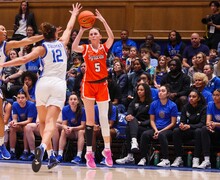Study reveals frequency of sexual assault on college campuses
An average of one in every four female college students experience sexual assault during their undergraduate years, according to a study from the Bureau of Justice Statistics.
The findings were comprised of the responses of 15,000 women and 8,000 men from nine universities who filled out surveys in March 2015, according to the study, which was released on Jan. 20. The names of the participating schools were not revealed.
The study showed that on average, 21 percent of female undergraduates and 7 percent of male undergraduates said they had been sexually assaulted since starting college.
An average of 4.2 percent of female undergraduates said they had been sexually assaulted during the 2014-15 academic year.
“The one-in-four statistic is something we are very familiar with. This statistic is not surprising — it’s real,” said Marissa Blanchard, one of the co-founders of the Girl Code Movement and management and broadcast and digital journalism dual major at Syracuse University.
There was also some disparity in the results reported in the study, with the sexual assault experience rate ranging from a high of one in two at some of the schools that were surveyed to a low of one in eight.
“The main issues with these statistics is that sexual assault is the most underreported crime,” Blanchard said. “Many universities do not have strong reporting systems in place, or discourage survivors from reporting.”
The findings of the study reflect similar results found in other studies about sexual assault on college campuses. For example, a study from the Association of American Universities found that 23.1 percent of female college students said they experienced unwanted sexual contact. SU is not a member of the AAU, according to the AAU website.
Blanchard said most sexual assualt survivors do not report the incidents to police due to various reasons, such as the fear of not having anyone believe them, the pressure of having concrete evidence as “proof” and the discouragement they receive from universities for wanting to report their cases to the police.
“Recent studies show that most schools haven’t even investigated a sexual assault case in over five years,” she added. “When I see a school has zero reports, that’s a huge red flag that something is seriously systematically wrong at that institution.”
SU has not been subject to a Title IX investigation for sexual assault since at least April 2011, according to data collected by the Chronicle of Higher Education.
Vice President Joe Biden visited SU in November and spoke about sexual assault prevention as a part of the “It’s On Us” campaign, a national effort from the White House that works to end sexual assault on college campuses.
Blanchard said awareness campaigns like “It’s On Us” are “great but not enough,” as awareness can only go so far. She added that the biggest issue in combating sexual assault is implementing efficient reporting procedures.
“The current system sends survivors to many different locations on campus, forces them to tell their story and relive it several times, and often does not lead to a conviction,” Blanchard said about sexual assault procedures at universities across the country.
She added that there is no incentive for universities to report these cases.
Blanchard said her biggest piece of advice to survivors of sexual assault is to ask for help or talk to someone in the Counseling Center.
Published on February 17, 2016 at 10:07 pm
Contact Deniz: dsahintu@syr.edu





